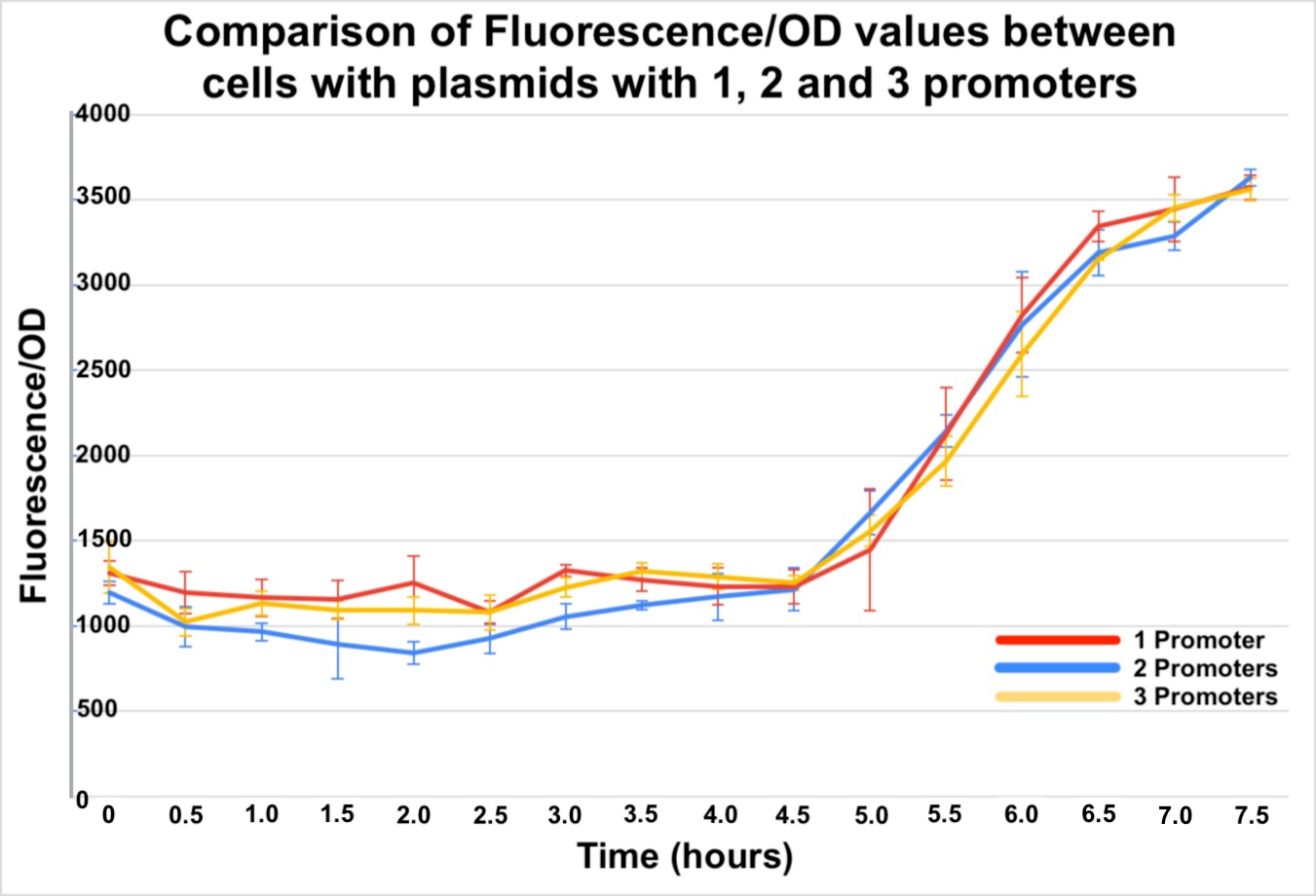Part:BBa_K3017081
rfp with 2 strong promoters
This construct was designed as one of the parts to characterize possible competition between promoters of the same type.
A complex genetic circuit used in our project has multiple constitutive promoters BBa_J23110 and BBa_J23104. These are promoters from the Anderson Promoter Collection and are highly similar in terms of recruitment of transcription factors. We were worried that this may cause competition of transcription factors between these promoters, resulting in undesired imbalance and other possible interferences. Therefore, we conducted an experiment to characterize such possibility in interference.
The experimental constructs are pSB1C3 plasmids containing 1, 2 and 3 promoter-RBS sequences in an RFP-containing backbone, i.e. n={0,1,2}. These constructs are sequentially added using EcoR1, Xba1 and Spe1 sites. In this part, n=1 and there are a total of 2 BBa_J23104 in the plasmid.
Characterization
DH5-α E. coli transformants of the plasmids, namely 1P (n=0), 2P (n=1), and 3P (n=2), were incubated overnight to reach saturation. The next morning, saturated cell cultures are diluted to a designated OD ready for exponential growth. Diluted cell cultures are then incubated. Every 0.5 hours over a 7.5 hours span, a portion of the cell culture is quenched. After samples are taken from every time point, i.e. after 7.5 hours, OD600 and fluorescence level (ex:586nm; em:611nm) are measured by a plate reader. The amount of fluorescent protein in a single cell is implied from the fluorescence/OD values.
The graph shows no notable correlation between the number of promoters present in the plasmid and the level of fluorescence protein expression. Our model circuit only contains 3 constitutive promoters (all BBa_J23104), which is the same case as the experiment conducted. Accordingly, we conclude that there is no significant restraint in protein expression in our model circuit.
However, we suspected curves without significant correlation, as the one above, can only be replicated when the experiment is done with small numbers of promoters. Below we discuss what might be the reasons.
It is speculated that the amount of FTs is largely in excess in an E. coli cell. Therefore, the increase in the number of promoters from 1 to 3 might not be significant compared to the abundance of TFs. The constitutive promoter BBa_J23104 uses sigma factor σ70, which is the primary sigma factor in E. coli which transcribes most genes in the log phase[1]. Together with the fact that the experiment is done in the log phase, it is reasonable that the bacteria has a large intrinsic abundance of corresponding TFs, leading to insignificant competition.
Still unsure of the cause of the results, we would like to do experiments in the future using other independent variables. We will also consider the cell type, plasmid copy number, and phase when the experiment is conducted.
References:
[1]J. MIKI, I. AKIRA, U. SUSUMU, and I. AKIRA, “Regulation of RNA Polymerase Sigma Subunit Synthesis in Escherichia coli: Intracellular Levels of Four Species of Sigma Subunit under Various Growth Conditions,” vol. 178, no. 18, Sep. 1996.
Sequence and Features
- 10COMPATIBLE WITH RFC[10]
- 12INCOMPATIBLE WITH RFC[12]Illegal NheI site found at 7
Illegal NheI site found at 30
Illegal NheI site found at 919
Illegal NheI site found at 942 - 21COMPATIBLE WITH RFC[21]
- 23COMPATIBLE WITH RFC[23]
- 25INCOMPATIBLE WITH RFC[25]Illegal AgeI site found at 616
Illegal AgeI site found at 728 - 1000COMPATIBLE WITH RFC[1000]
| None |


